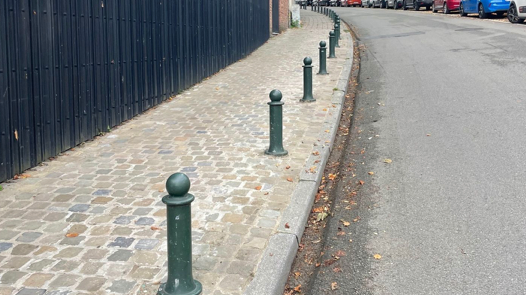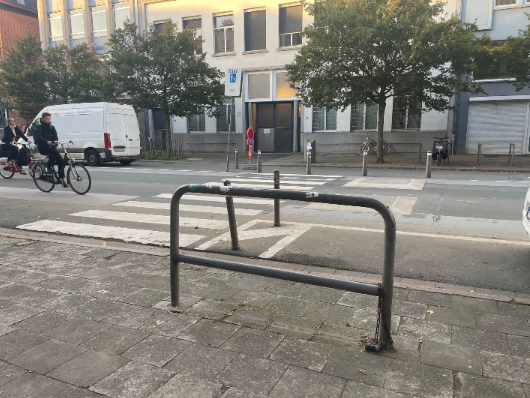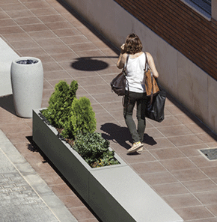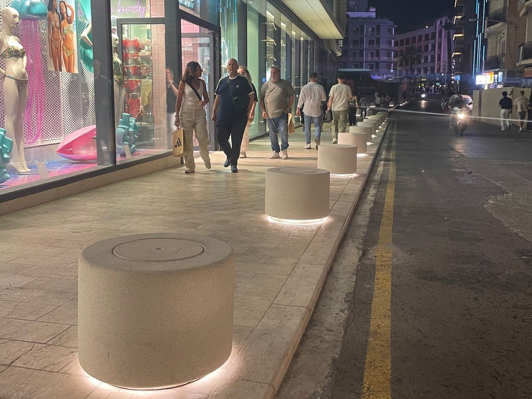Summary
In this article, we explore why bollards, fences and barriers have appeared so massively in public space, what consequences this has for safety, inclusion and accessibility, and how cities are increasingly choosing pedestrian-friendly streets. Using examples from the Netherlands and Belgium, we show how the focus can shift from scattered obstacles to multifunctional solutions such as benches, planting beds and illuminated seating elements. We offer practical pointers for gradually replacing bollards with solutions that create space for quality of stay, climate adaptation and social interaction.
A Quiet Invasion in Our Streets
Bollards, fences and barriers are popping up everywhere in our streets. They are meant to keep cars out and protect vulnerable road users, but at the same time they create new obstacles for cyclists and pedestrians. Meanwhile, cities are investing in pedestrian zones, campaigns promoting walking and creative forms of placemaking. This raises the question of how we can move from a tangle of bollards to legible, comfortable and multifunctional places for everyone, without letting public space degenerate into visual and spatial clutter.
Anyone who looks closely at an average street often sees the same pattern returning. Where there used to be a wide pavement, there is now a double row of concrete bollards along the kerb. Extra railings appear in front of charging stations. In places where the square could still have been open, the space has been cut up into fragments by blocks and scattered objects. What was once a single, clearly readable space is turning into a fragmented course of small interventions.

The excess of low stone bollards and wedge-shaped block do keep cars in their designated road space but they also turn the pavement into a slalom of hard obstacles, risky for cyclists and uncomfortable for wheelchair users.
Many of these measures are understandable. Road authorities want to prevent rat-running traffic, protect footpaths and create clear separations between flows. Bollards can be installed quickly, are relatively cheap and give the short-term impression that something has been done about a problem. In this way, a temporary measure silently grows into a standard solution.
The result is a streetscape increasingly defined by objects that mainly prohibit something. They mark boundaries and block passageways, but add little to the quality of stay, legibility or comfort. Public space feels less like a continuous network of places and more like a collection of technical fixes.
The Invisible Walls of Exclusion
Every bollard we install also tells a story of missed opportunities and unintended consequences. One of the most painful is how this quiet invasion can collide with the ambition for inclusion and accessibility. For many people, these obstacles become literal, invisible walls.

On narrow pavements, a line of bollards can mean that two people can no longer walk side by side comfortably. Imagine that you encounter another person or even a wheelchair user in this layout.
Think of wheelchair users weaving between bollards and barriers. Parents with a buggy who cannot find a straight line to the pedestrian crossing. People with visual impairments for whom every unexpected obstacle is a potential danger. What was initially meant to protect gradually turns into an obstacle course. On many pavements, barely enough free width remains for people to pass each other comfortably.
In our ambition to push back the car, we sometimes unintentionally exclude people. Truly public space should be accessible and safe for everyone, not just for those who can move easily around obstacles. That requires design decisions which look beyond the immediate traffic problem and take into account guidelines on minimum clear widths, turning spaces and the legibility of routes for blind and partially sighted people.
The Hidden Costs for Cyclists and Pedestrians
Bollards do have a real safety function, but they also bring risks and costs. Dutch studies estimate that every year thousands of cyclists are involved in single-vehicle crashes with bollards, often with serious injuries as a result. These are not only collisions with poorly visible posts on cycle paths, but also falls when swerving to avoid them.
A sample by Fietsersbond Nederland (the Dutch Cyclists’ Union) showed that many existing bollards do not comply with the guidelines. Gaps are too narrow, posts stand exactly in the expected line of travel or lack clear markings. These are situations that many road managers will recognise in their own municipality.
That is why organisations such as Fietsersbond Nederland use reporting points and “bollard campaigns”, and local authorities draw up reports in which all obstacles are systematically mapped. As a result, the discussion shifts from the question of whether a bollard is needed somewhere to the question of how the overall design can be made better and safer.
Importantly, this is not only about cycling. Bollards and railings also affect pedestrians. Narrow pavements full of barriers make it difficult to walk side by side with a buggy, walker or wheelchair. The key question is no longer only whether cars are being kept out, but for whom the street is still truly usable. The focus shifts from placing individual bollards to designing comfortable, clearly legible routes for all active road users.
Everyone a Pedestrian
Campaigns by the Voetgangersbeweging (Pedestrian Movement), Infopunt Publieke Ruimte and partners in Flanders place the pedestrian perspective firmly on the table. They emphasise that everyone walks a part of their daily journeys and that accessible, obstacle-free public space is essential for both comfort and safety.

Metal barriers at a pedestrian crossing may seem to offer extra protection, but they break the natural walking line and make the crossing more complex for many users.
Initiatives such as the “Month of the Pedestrian” in October highlight this every year. In Flanders, attention to comfortable and safe walking routes is growing: through the Fietsrapport, problem locations – including wrongly placed bollards – are increasingly being mapped and discussed with local authorities. In this way, a broader awareness emerges that pedestrians need clear walking lines, sufficient resting points, recognisable seating elements and readable crossing points.
For designers and policy makers, this is an important shift. Whereas the classic bollard logic mainly thinks from the perspective of vehicles, the pedestrian perspective starts from walking comfort and quality of stay. A metal barrier in front of a zebra crossing no longer looks like extra protection, but like an unnecessary obstacle in the walking line that in fact undermines the safety and independence of pedestrians.

Even in newly designed residential streets, bollards often remain the standard solution, although their shape and detailing are more refined and better integrated into the street profile.
From Bollard to Place: Towards Multifunctional Street Furniture
An alternative to the control-driven approach is to look at streets through a placemaking lens. Instead of asking where a bollard is needed, the central question becomes how stay, orientation and safety can be combined in one place.
Elongated planters, alternated with seating, are a clear example. They keep vehicles at a distance from the pavement, but at the same time add greenery, offer a place to sit for a moment and make the walking line clear. When these planting beds can also buffer water and contribute to cooling on hot days, they become a response to climate challenges such as heat stress and heavy rainfall. Illuminated seating elements along a busy footpath mark the edge of the pavement, increase visibility and offer protection. At the same time, they can serve as informal seating and enhance the experience of the street in the evening hours.

Elongated planters combined with seating elements create a soft barrier between pavement and roadway, add greenery and keep the walking line wide , legible and free of clutter. And additionally they offer spaces for seating.
Subtle changes in level, wide seating edges around planting beds or a carefully placed row of trees can also mark the transition between traffic zone and place to stay. The difference with classic bollards is that these elements combine multiple functions: delineating, inviting, orienting, greening and often also contributing to climate adaptation. One well-designed element can replace dozens of small obstacles.
More Pedestrian Zones, Less Need for Point Solutions
In cities that consciously reallocate space, the role of the bollard changes. In streets designed entirely around cars, a bollard is often the last safety net to protect vulnerable users. However, when a street is clearly laid out as a pedestrian or stay-first area, the number of scattered obstacles can be reduced and more can be achieved with surface design, material changes, trees and seating objects.
This shift is increasingly reflected in policy. During car-free Sundays, for example in Brussels, large parts of the city are turned into a pedestrian zone for a day. Streets are closed to motorised traffic and the city as a whole is experienced at walking pace.
Internationally, cities like Paris, San Francisco, Vilnius and Bogotá are investing in low-traffic riverfronts, pedestrian promenades and streets where the car is no longer the main guest. European networks support this movement with knowledge-sharing and guidelines for liveable, child-friendly streets.
In such a context, it becomes possible to use the classical bollards elements more sparingly and more strategically. Not every conflict situation still needs to be solved with an extra obstacle. By structurally giving space to pedestrians, the need for technical point solutions decreases and room emerges for pleasant places to stay.
Smart Design Is a Sustainable Investment
On the surface, a bollard seems like a simple and cheap solution in the short term. In practice, there are additional costs: management, replacement after damage, liability in the event of accidents and the social impact of an inaccessible or unattractive street. Ten individual bollards may look cheaper on paper than one robust seating edge, but spread over decades of maintenance and replacement, the reality is often the opposite.
A carefully designed multifunctional intervention requires a higher initial investment, but frequently yields more in terms of safety, social cohesion and quality of stay. A planting bed that simultaneously buffers water, provides a seating edge and keeps the walking line clear. A series of illuminated seating blocks that both protect and invite. A row of trees that shields street and pavement without blocking sightlines and at the same time provides shade on hot days.

Illuminated seating elements along the pavement demarcate the pedestrian zone, improve visibility and create a safe, attractive shopping street in the evening.
These kinds of solutions connect directly to campaigns that promote a pleasant and easy-to-walk network of streets and squares. They support policy goals around climate adaptation, health and social interaction, without filling public space even further with isolated obstacles.
Beyond Defensive Design: Building Trust
The shift from bollards to street furniture is more than a practical swap; it is a fundamental step away from defensive urbanism. We no longer design from fear of misuse, but from the desire for good, everyday use. By choosing integrated solutions in public space, we build an environment that invites people in and radiates trust.
We see more design offices demonstrating in their projects how street furniture, lighting and material choices together can create a sense of openness and freedom, without compromising safety or functionality. Such examples prove that designers do not have to choose between aesthetics and control – they can literally give shape to trust in the public realm.
This leads to a higher Social Return on Investment (SROI): the space becomes not only safer and more functional, but also more social, greener and economically more vibrant.
Fewer Bollards, More Imagination
The conclusion is not that all bollards must disappear. In some situations, a clear, well-placed bollard remains the most logical choice, for example where vehicles really must be kept out and space is tight. What is growing, however, is the awareness that bollards do not have to be the default solution for every design problem in public space.
By asking, with every intervention, whether a bollard is truly necessary, whether walking and cycling lines are clear and obstacle-free, and whether an object can fulfil more than one function, a different streetscape begins to emerge. Fewer scattered obstacles, more places that invite people to walk, cycle, sit and meet one another.
In this way, we move towards public space that is not defined by bollards, but by places where people actually want to be. With smart combinations of benches, planters, planting beds, lighting and guidance – designed for both cyclists and pedestrians. And with bollards only where they are genuinely indispensable. Every time we draw a bollard into a plan, we can ask ourselves: could this become a place instead?